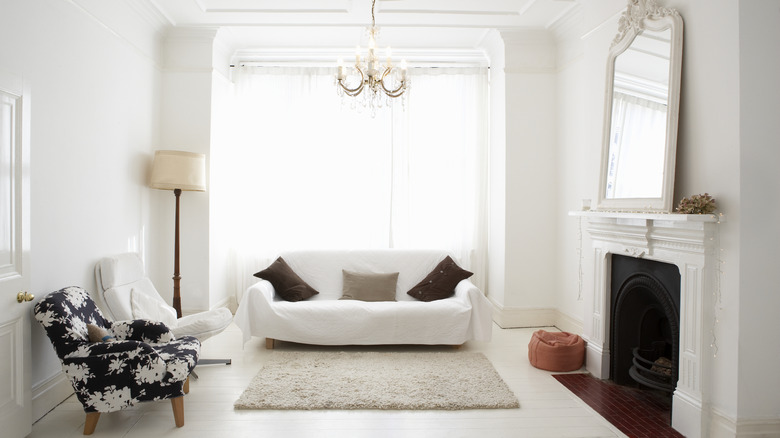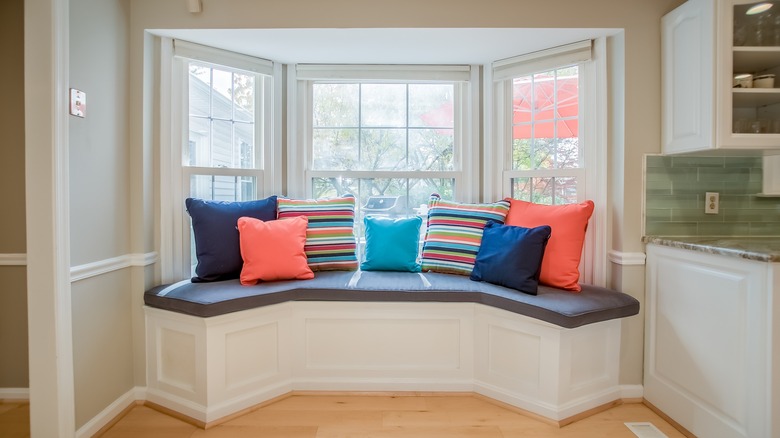What A 'Keeping Room' Is And Tips To Create Your Own
While some trends are better left in the past, others are making a bigger comeback than a semi-retired rockstar, and one that's gaining popularity again is a keeping room. If you're new to the idea of a keeping room, this might be the heads up you need to consider creating one in your home, or at least bookmarking the idea if you ever live in a residence that features one. Keeping rooms were popular in Colonial times when heat was a precious commodity. Family members and visitors who weren't cooking could congregate in a keeping room, which was an area for socializing that existed off the kitchen but still benefited from the heat produced by the fireplace (or the hearth as it was better known then).
While most homes now come complete with central heating and most kitchens don't have fireplaces, a keeping room is still an excellent way to introduce a space that can house people who want to spend time near the kitchen without being in the way. Whether you're hosting or your family tends to gravitate toward the kitchen as a social hangout spot, creating an area that introduces comfort and community is a great way to make everyone happy, and since experts warn against TVs in the kitchen, this is a great substitute for entertainment. Many homes built during the Colonial era already feature this "nook" or room, but you can still indulge in one even if your home didn't see powdered wigs and a Revolution.
Creating a cozy keeping room
The key to nailing a keeping room is that it must be off of the kitchen, as this provides both warmth and close proximity to those who are preparing food or executing other tasks there. If your home features a small extension off of the kitchen, this is likely considered a keeping room. Sometimes people turn these into breakfast nooks, but due to the (usually) small nature of the space, there may not be much room for a table and therefore can be filled with comfortable furniture to lounge in instead. If you're in a house that doesn't feature a keeping room, you have several options on how to include one in your existing floor plan.
For open-concept areas, forgo an island and instead install comfortable seating options like a small couch and some cozy chairs within talking and viewing distance of the cooking portion of your layout. Where islands usually require you to pick high-top seating that can be uncomfortable after long stints, keeping rooms allow people to interact in a more comfortable setting. For new builds, you can ask your contractor or builder to add a little square footage onto your kitchen, creating just enough space to situate some furniture and maybe a small table to hold snacks and drinks. If there is a fireplace in your cooking area, this is the ideal spot to include a keeping room, or you can have one built when creating your new floor plan.
Keeping rooms are all about including cozy elements
If you've already designated a space like this for a breakfast nook, why not replace the table or brunch dinette with oversized chairs, a loveseat, or a comfortable built-in bench? This still allows people to enjoy coffee, tea, or breakfast but in a more cozy setting. By including storage fixtures like shelves or a side table with drawers, you can also use your keeping room as a place to partake in hobbies while enjoying people's company in the adjoining kitchen. Crafting items can be stowed out of sight until needed, allowing the room to serve as a functional area while also being a quaint nod to simpler times.
Wicker accents and plush, cozy fabrics can unexpectedly upgrade your kitchen and create an inviting atmosphere. However, while you want this room to be inviting and chic, keep in mind that it does lie very close to the kitchen where spills, food prep, and mess exist in abundance. For these reasons, furniture that features stain-resistant materials is ideal. Depending on the theme of your cooking area, bring in colors that complement your decor scheme and aesthetic. The keeping room can include pops of color, but just ensure these flow with what you already have or plan to build in your kitchen so it doesn't look disjointed. For all black kitchens, cream fabrics, teal or green accents, and wood elements will match nicely, while white kitchens can benefit from natural woods and blues for airiness.


